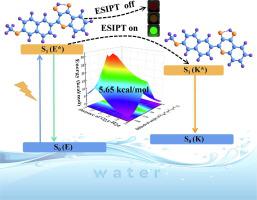Spectrochimica Acta Part A: Molecular and Biomolecular Spectroscopy ( IF 4.3 ) Pub Date : 2023-06-05 , DOI: 10.1016/j.saa.2023.122945 Yu Wan 1 , Qi Li 1 , Lixia Zhu 1 , Yongfeng Wan 1 , Lu Yan 1 , Meilin Guo 1 , Hang Yin 1 , Ying Shi 1

|
Fluorescent probes with excited state intramolecular proton transfer (ESIPT) properties play a significant role in the research of life science and material science. Guo et al. designed 3-hydroxy-2-(6-Methoxynaphthalen-2-yl)-4H-chromen-4-one (MNC) as a control to achieve the dual-color fluorescence imaging of lipid droplets and endoplasmic reticulum (ER). They deemed that the ESIPT process would be turned off in ER with high water content [J. Am. Chem. Soc. 2021, 143, 3169–3179]. However, contrary to the conventional ESIPT off case, the enol* state fluorescence intensity that should have been enhanced was severely quenched in water. Here, combined with ultrafast spectrum, steady-state fluorescence spectrum and potential energy surface, the mechanism of ESIPT process of MNC turned off in water is revised. Furthermore, the formation of aggregated states in water is responsible for the quenching of MNC fluorescence. This work is expected to provide broader ideas for the design of hydrophobic fluorescent probes.
中文翻译:

水溶液中荧光探针 MNC 的 ESIPT 关闭机制的再思考
具有激发态分子内质子转移 (ESIPT) 特性的荧光探针在生命科学和材料科学的研究中发挥着重要作用。郭等。设计了 3-hydroxy-2-(6-Methoxynaphthalen-2-yl)-4H-chromen-4-one (MNC) 作为对照,实现了脂滴和内质网 (ER) 的双色荧光成像。他们认为 ESIPT 过程将在高含水量的 ER 中关闭 [J. 是。化学。社会。2021, 143, 3169–3179]。然而,与传统的 ESIPT 关闭情况相反,本应增强的烯醇*态荧光强度在水中严重淬灭。在此,结合超快光谱、稳态荧光光谱和势能面,对MNC在水中关闭的ESIPT过程的机理进行了修正。此外,水中聚集态的形成是 MNC 荧光猝灭的原因。该工作有望为疏水性荧光探针的设计提供更广阔的思路。





















































 京公网安备 11010802027423号
京公网安备 11010802027423号